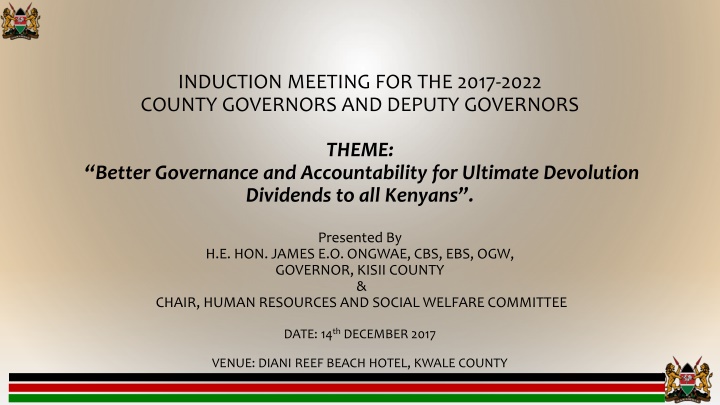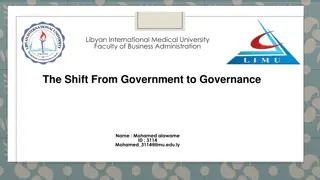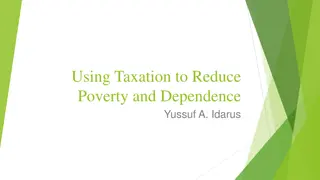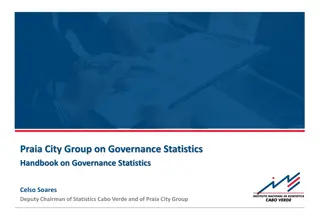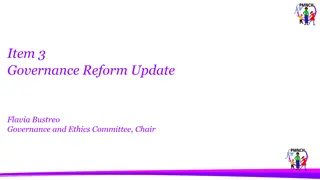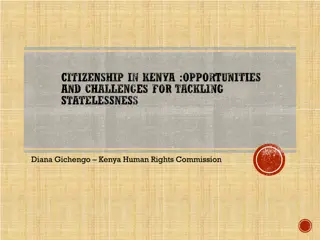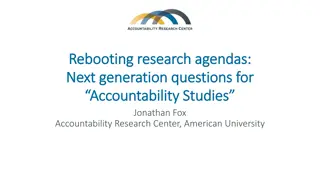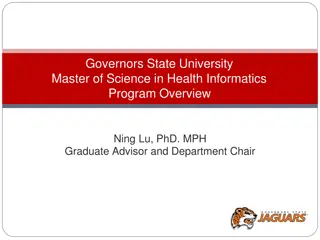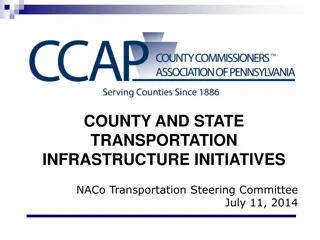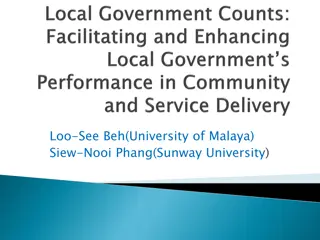County Governance and Accountability: Key Areas of Focus for Kenyan Governors
H.E. Hon. James E.O. Ongwae, Governor of Kisii County, presented on the theme of "Better Governance and Accountability for Ultimate Devolution Dividends to all Kenyans" at the induction meeting for the 2017-2022 County Governors and Deputy Governors. He highlighted the importance of effective management of human resources, county pension management, and handling of industrial and labor relations in County Governments. The speech emphasized the need for efficient processes from recruitment to separation to ensure quality service delivery.
Download Presentation

Please find below an Image/Link to download the presentation.
The content on the website is provided AS IS for your information and personal use only. It may not be sold, licensed, or shared on other websites without obtaining consent from the author.If you encounter any issues during the download, it is possible that the publisher has removed the file from their server.
You are allowed to download the files provided on this website for personal or commercial use, subject to the condition that they are used lawfully. All files are the property of their respective owners.
The content on the website is provided AS IS for your information and personal use only. It may not be sold, licensed, or shared on other websites without obtaining consent from the author.
E N D
Presentation Transcript
INDUCTION MEETING FOR THE 2017-2022 COUNTY GOVERNORS AND DEPUTY GOVERNORS THEME: Better Governance and Accountability for Ultimate Devolution Dividends to all Kenyans . Presented By H.E. HON. JAMES E.O. ONGWAE, CBS, EBS, OGW, GOVERNOR, KISII COUNTY & CHAIR, HUMAN RESOURCES AND SOCIAL WELFARE COMMITTEE DATE: 14thDECEMBER 2017 VENUE: DIANI REEF BEACH HOTEL, KWALE COUNTY
Introduction: First of all, I congratulate all Excellency Governors and Deputy Governors who successfully campaigned and got electedin the last general election. I want to submit at the outset that the grueling task we went through during the campaign period is nothing compared to the daunting task that confronts us in Managing the Public Service for Effective Service Delivery which is the broad topic of our discussion today. Yet, I am confident that we shall rise to the task and put in place a workforce that will deliver to the expectations of every Kenyan.
I will address the following three areas: My experience on effective management of human resources in County Governments: County Pension management and Handling of industrial and labour relations.
Effective Management of Human Resources in County Governments: The Constitution, under Article 235 (1), mandates Counties to handle all matters relating to staffing within County Governments and states: A County Government is responsible, within the framework of uniform norms and standards prescribed by an Act of Parliament to: a. Establish and abolish offices in its Public Service; b. Appoint persons to hold or act in those offices, and confirm appointments; and c. Exercise disciplinary control over and remove persons holding or acting in those offices.
Continuation: Effective management and administration of the human resource can only be realised when it takes into account the entire process right from recruitment, progression, motivation, appraisal and separation of the employee. Each of these stages must be carried out in the most efficient manner, as the quality of staff employed will determine the quality of service they will deliver. Unfortunately, this is often ignored and at very debilitating consequences.
County Governments Experience The pioneer Governors in 2013, inherited a pool of personnel that didn t have requisite skills yet they couldn t sack them because they were protected in law for the three-year transition period. These personnel didn t have the requisite qualifications, and therefore counties were forced to hire new officers to deliver on their mandate.
Continuation: This created a bloated wage bill where many of our workers are underemployed which depresses productivity levels of county governments. Currently, County Governments have three (3) types of workers; 1. officers inherited from the former local authorities 2. officers seconded from national government 3. new officers employed through county public service boards
County Public Service Boards They are charged with handling human resource issues in the County including developing and implementing human resource policy guidelines. The existing policies were customized from national government so it is not clear which code of regulations they should follow. The relationship between County Public Service Boards and the Executive is not clear and in some instances, some County Assemblies interfere with their operations.
Recruitment: In most instances, selection of officers to serve in Counties was done through ascription (arbitrary placement) rather than meritocracy owing to other considerations like politics, affirmative action, cultural diversity, community interests and equity. In effect, this has created a pool of employees without requisite skills and attributes to deliver as per the job requirements. CAREER PROGRESSION GUIDELINES/SCHEMES OF SERVICE; The three categories of staff in Counties come with different schemes of service. Standardization is lacking across Counties and there is no clear policy on horizontal and vertical transfers. Movement of staff between Counties and between the two levels of government is not possible. Equally, there is varying designation/titles nomenclature, for instance, a senior administrative assistant in one county is on job group K while in another they are in Job Group Q . To effectively manage these staff, Counties need to develop uniform regulations, codes of conduct and schemes of service.
Discipline: Modalities for disciplining staff at the Counties are not clear. Counties need to have in place ministerial disciplinary committees and selection committees that feed into the County Public Service Boards. Counties should have a complete County Disciplinary Committee that can recommend disciplinary measures including separation or termination of service. Termination modalities are currently not clear. Staff Welfare/Benevolent Fund: In most Counties, welfare arrangements for staff are lacking. Counties need to have this component in the budget. similarly, staff who carry out jobs that expose them to risk need personal accident and other insurance covers.
Training and Capacity Building: This function has not been devolved and funds for this purpose are retained in national government through the ministry of devolution. There is no itemization of this function in the County Government budget making it difficult to improve capacity among our staff. Retirement: The code of regulations for retirement has not been picked by County Public Service Boards regarding advice on retirement and the policy on voluntary retirement by the employer is not clear.
Recommendations: 1. During the second term of devolution, there is need for Counties, through the Council of Governors, to debate and agree on uniform code of regulations and schemes of service for employees with options for Counties with peculiar conditions to have privileges in order to attract skilled staff to their areas. 2. Counties need to develop career progression guidelines, and those that have not done so would do well to look at what happens in National Government. Issues of promotion have brought challenges where they are done haphazardly contributing to a bloated wage bill. 3. Counties need to cascade and entrench the equivalent of the ministerial training committee to handle training and capacity building and the inter- ministerial advisory committee to handle discipline and other issues.
Continuation on Recommendations 4. We need to address the record keeping challenges in counties especially on financial and personnel matters. Counties need to establish open and confidential/secret registries for personnel. 5. Finally, we must set aside funds for training and capacity building. Training is a continuous activity in any organization but Counties have not been able to effectively carry out this important activity because training resources have not followed the function. We need to discuss this matter through the intergovernmental budget and economic council (IBEC) to ensure funds for training and capacity building are devolved to allow counties train staff for effective service delivery.
SECOND TOPIC OF DISCUSSION IS: COUNTY PENSION MANAGEMENT & OPTIMAL STRUCTURES FOR IMPLEMENTATION
COUNTY PENSION MANAGEMENT Section 132 of the County Governments Act, 2012 provides that all members, officers and staff of a County Government shall subscribe to an existing pension scheme for officers and staff of local government. As I have already indicated, we have three (3) different categories of staff; 1. those inherited from former Local Authorities 2. those seconded from National Government 3. those employed through County Public Service Boards Equally, in County Governments, employees belong to two types of pension schemes. those seconded from National Government belong to the non-contributory pension scheme while others belong to the contributory pension scheme (defined pension scheme).
Non-contributory Scheme/ Provident Fund This is a scheme for the payment of lump sums and other similar benefits to employees when they leave employment or to the dependents of employees on the death of those employees. Defined Contributory Scheme A Defined Contribution (DC) Scheme; is a scheme in which member' and employer' contributions are fixed either as a percentage of pensionable earnings or as a shilling amount. Defined contributory schemes are arrangements where the retirement benefit is not known or defined in advance Therefore, staff in the provident/non contributory scheme have better superannuation arrangement compared to those in the Defined Contributory scheme yet they work side by side in County Governments.
Existing Retirement Benefits within the Counties Currently there are three (3) retirement benefits schemes existing within the County Governments, namely; 1. Local Authorities Pension Trust (LAPTRUST); 2. Local Authorities Provident Fund (LAPFUND); and 3. LAPTRUST (umbrella) retirement fund [the County Pension Fund]. These were essentially pension funds for staff that served in former Local Authorities. Governors sat and decided they wanted to form their own pensions fund and the benefits for this arrangement are many. for example, Member contributions form a resource pool from which Counties can borrow to carry out development projects. Emboldened by this reality, Governors requested a meeting on pensions on 6th December 2013 bringing together the Council of Governors, the Senate Committee on devolution and the Transition Authority. A technical committee was set up to recommend a suitable pension arrangement for County Governments.
Membership Composition for the Technical Committee: The membership was drawn from the following organizations: 1. Retirement Benefits Authority (RBA), 2. National Treasury (Pensions Department), 3. Salaries and Remuneration Commission (SRC), 4. Transition Authority (TA), 5. Council of Governors (CoG), 6. Ministry of Devolution and Planning (directorate of public service management), 7. Commission for the implementation of the Constitution, 8. Kenya Law Reform Commission (KLRC), 9. public service commission (PSC), 10. Speakers Forum and County Public Service Boards Forum.
Establishment of a County Pensions Fund After several consultative meetings with all the stakeholders including LAPTRUST and LAPFUND, The technical committee recommended the following;- i. Establishment of an umbrella Pension Scheme for the staff of the Counties through an Act of Parliament. ii. Closure of LAPTRUST (defined benefits pension scheme) and LAPFUND (defined contributions provident fund) to new members because it was unsustainable to operate them with their huge liabilities. iii. Merging of the administrative services of the two schemes LAPFUND and LAPTRUST to iv. provide administration services to the two closed funds as well as the umbrella scheme in order to v. benefit from the experiences, systems, people and processes of the current administrators of the two funds.
Management of the Fund LAPTRUST was basically managed by Local Governments while LAPFUND was managed as a State Corporation but both were funds for Local Authority staff and therefore, funds therein belonged to Local Authorities. LAPFUND however, wants to be administered by the National Government yet their members are in Counties. National Government wants to control these funds yet County Governments have control over their members. ADOPTION OF THE COUNTY PENSION FUND On May 14th 2014, County Governments adopted all recommendations of the technical committee save for the recommendation on establishment of an umbrella scheme due to provisions in law requiring County staff to subscribe to an existing Pension Scheme. Following subsequent stakeholder consultations, it was agreed that the LAPTRUST Fund be adopted and renamed the County Pension Fund (CPF). The Trust Deed and Rules have since been amended to reconstitute the fund and align it to the County Government structure.
COUNTY PENSION SCHEME BILL, 2016 The umbrella retirement fund is to be anchored in law through a senate legislative process. Senate has since published the County Pension Scheme Bill, 2016 that seeks to, among other things, anchor the CPF under an Act of Parliament. County Governments, as employers, have an responsibility to protect employees rights to access social security (pension). We urge Senate to expedite the enactment of this law to address the issue of pension for county staff substantively.
THIRD TOPIC OF DISCUSSION IS: HANDLING INDUSTRIAL AND LABOUR RELATIONS
Labor Relations Act Provisions of the Labour Relations Act no. 14, 2007, guide the matters relating to the handling of industrial and labour relations. This Act creates efficient and responsive operational procedures to promote Employment Relations and Labour peace in the Country. It does promote the collective bargaining process by encouraging parties to engage in good faith. SIGNING OF COLLECTIVE BARGAINING AGREEMENTS (CBA S) The question we need to ask is: Do counties have the capacity to handle Labour Relations especially signing of Collective Bargaining Agreements (CBA s)?
Industrial Strife in Health care sector at the Counties The health sector faced industrial strife pitting health workers against County Governments. First it was the doctors strike that started on 5th December 2016. Our contention as cog was that doctors had signed a defective collective bargaining agreement (CBA) with the national government. The Ministry of Health surpassed its mandate to enter into an agreement with doctors because in 2013, we had a new Constitutional dispensation where health had been devolved so doctors were to negotiate with individual counties. As Governors, we began negotiations and a mediation process that culminated into the signing of a Return To Work Formula on 14th march 2017. This paved way for the parties to draw and negotiate both the Recognition Agreement (RA) and subsequently the CBA which were signed on 6th July 2017 and registered with the Employment and Labor Relations Court
Nurses Strike The Kenya National Union of Nurses (KNUN), issued a 21-day strike notice on 14th November 2016, wanted to go the same route as doctors demanding finalize and sign the RAs and CBAs. Through the CoG, the MoH and County Governments, we negotiated and reached a Return To Work Formula (RTWF) and awarded Nursing Service Allowance which costs County Governments Kshs.5.79 billion annually. It was agreed that 2017-2021 a CBA be negotiated between KNUN and County Governments, an exercise that commenced on 2nd February 2017. Counties maintained they could only sustain allowances approved by SRC and subsequently, nurses abandoned negotiations prematurely and went on an unprotected strike. The Five (5) months strike ended on 2nd November, 2017 after all parties agreed to conclude the CBA and implementation modalities for the new allowances. The negotiations for the CBA are at the tail end through the Council of Governors.
Way forward We are well aware that more issues will emerge regarding Labour Relations where for instance workers in the Agricultural sector or Accountants may raise demands. We need collaboration between County Governments and National Government s Ministries of Finance, Agriculture, Labour, the SRC and the Public Service Commission (PSC) in handling these issues. We must ensure that all actions taken on this matter are within the boundaries of the law and the existing jurisprudence. My brothers and sisters, the new Governors, need to be careful on whatever action they take regarding industrial action. Any action or decision should be within the law and should consider issues of uniformity because all 47 counties work as a team. In conclusion, I wish to re-state that the first term was a learning experience for all players in the devolved system of governance. We need to consolidate the gains made and sustain the momentum for full implementation of devolution.
